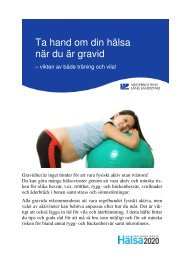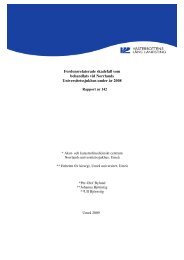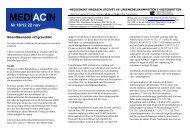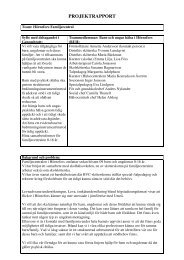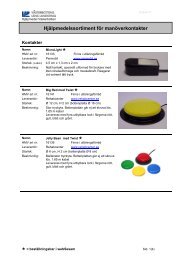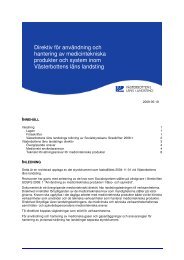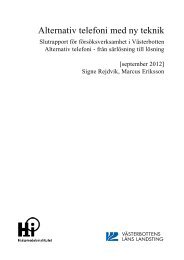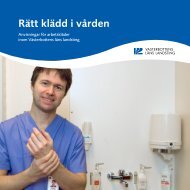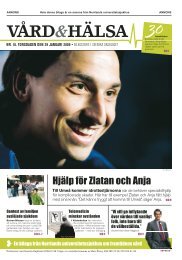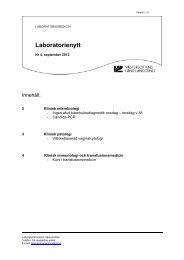An interventional approach to increase the intake of fruits and ...
An interventional approach to increase the intake of fruits and ...
An interventional approach to increase the intake of fruits and ...
Create successful ePaper yourself
Turn your PDF publications into a flip-book with our unique Google optimized e-Paper software.
<strong>An</strong> <strong>interventional</strong> <strong>approach</strong> <strong>to</strong> <strong>increase</strong><br />
<strong>the</strong> <strong>intake</strong> <strong>of</strong> <strong>fruits</strong> <strong>and</strong> vegetables<br />
among parents <strong>and</strong> <strong>the</strong>ir children in<br />
Västerbotten, Sweden<br />
Sophia Hendriks<br />
Jutta van Ho<strong>of</strong>t<br />
Student<br />
Vt 2012<br />
Health Promotion in Food <strong>and</strong> Nutrition, 15 hp
Abstract<br />
Introduction This processing <strong>of</strong> <strong>the</strong> intervention was part <strong>of</strong> <strong>the</strong> Salut programme with <strong>the</strong><br />
goal <strong>to</strong> improve <strong>the</strong> health <strong>and</strong> well-being <strong>of</strong> <strong>the</strong> population <strong>of</strong> Västerbotten. The target group<br />
were <strong>the</strong> parents-<strong>to</strong>-be <strong>and</strong> <strong>the</strong> parents. <strong>An</strong> adequate fruit <strong>and</strong> vegetable (FV) <strong>intake</strong> can<br />
contribute <strong>to</strong> a better health <strong>and</strong> can be influenced by several fac<strong>to</strong>rs. The FV <strong>intake</strong> was<br />
associated with several characteristics <strong>and</strong> <strong>the</strong>re were significant differences between <strong>the</strong><br />
mo<strong>the</strong>rs- <strong>and</strong> fa<strong>the</strong>rs-<strong>to</strong>-be. Open preschool Klossen located in Umeå was target <strong>of</strong> <strong>the</strong><br />
intervention. Klossen receives parents with <strong>the</strong>ir children in <strong>the</strong> age <strong>of</strong> 0-5 years old.<br />
Aims To develop <strong>and</strong> evaluate a child health promoting intervention programme that builds<br />
on <strong>and</strong> complements current multidisciplinary activities supporting children <strong>and</strong> <strong>the</strong>ir parents,<br />
<strong>and</strong> while doing so considering a life course <strong>approach</strong> <strong>to</strong> health.<br />
Method The designing <strong>of</strong> <strong>the</strong> intervention was based on <strong>the</strong> ‘GVO-model’ which is a Dutch<br />
model used for methodological research regarding Health Promotion. Behavioural models<br />
based on scientific research like ASE-model, stages <strong>of</strong> change model <strong>and</strong> I-change model<br />
were used <strong>to</strong> declare <strong>the</strong> behaviour <strong>and</strong> <strong>the</strong> behavioural determinants. Conclusions draw from<br />
<strong>the</strong> study ´Fruit <strong>and</strong> vegetable <strong>intake</strong> in relation <strong>to</strong> health-related <strong>and</strong> socio-economic<br />
characteristics among parents-<strong>to</strong>-be in Västerbotten, Sweden´ were used as basis <strong>and</strong> <strong>to</strong>ge<strong>the</strong>r<br />
with several visits at ‘Klossen’, including an <strong>intake</strong> interview <strong>and</strong> conversations with parents,<br />
<strong>the</strong> intervention was designed.<br />
Intervention The intervention exists <strong>of</strong> three domains. The first is ‘provided vegetables <strong>and</strong><br />
<strong>fruits</strong>’. By exp<strong>and</strong>ing <strong>the</strong> assortments <strong>of</strong> in particular vegetables <strong>the</strong> parents will be influenced<br />
by <strong>the</strong> healthy assortment. The second is providing breakfast which special focus on <strong>fruits</strong> <strong>and</strong><br />
last is vegetables in warm dishes like lunch <strong>and</strong> dinner. For each month <strong>of</strong> <strong>the</strong> year, Klossen<br />
can provide a recipe for <strong>the</strong> parents.<br />
Implementation Two implementation strategies were used, informing <strong>and</strong> educational. The<br />
organisation lies in <strong>the</strong> h<strong>and</strong>s <strong>of</strong> Klossen <strong>and</strong> it is <strong>the</strong>ir responsibility <strong>to</strong> execute <strong>the</strong><br />
intervention, this means that <strong>the</strong> teachers <strong>of</strong> Klossen are intermediaries. The intervention will<br />
start from September 2012 <strong>and</strong> <strong>the</strong> quality assurance will be done by Klossen <strong>and</strong> <strong>the</strong> Salut<br />
programme.<br />
Evaluation The evaluation consists <strong>of</strong> two parts, <strong>the</strong> process <strong>and</strong> effect evaluation.<br />
Process: <strong>the</strong> problems <strong>and</strong> obstacles found in <strong>the</strong> research are used as <strong>the</strong> basis <strong>of</strong> <strong>the</strong><br />
intervention. The research <strong>to</strong>ok more time than initially was planned but this made <strong>the</strong><br />
research <strong>and</strong> <strong>the</strong> <strong>the</strong>sis stronger which improves <strong>the</strong> suitability <strong>of</strong> <strong>the</strong> intervention. A way <strong>to</strong><br />
evaluate if <strong>the</strong> implementation <strong>of</strong> <strong>the</strong> intervention went well is <strong>to</strong> evaluate <strong>the</strong> sub aims <strong>of</strong> <strong>the</strong><br />
intervention.<br />
Effect: <strong>the</strong> main aim is used <strong>to</strong> evaluate <strong>the</strong> effect <strong>of</strong> <strong>the</strong> intervention. This can be done by<br />
giving a questionnaire <strong>to</strong> <strong>the</strong> parents with some questions <strong>to</strong> ask about <strong>the</strong>ir opinion <strong>of</strong> <strong>the</strong><br />
intervention. The evaluation can be repeated if necessary. Klossen also evaluates if <strong>the</strong>y are<br />
satisfied with <strong>the</strong> results. Finally it should be discussed how <strong>to</strong> improve <strong>the</strong> intervention<br />
according <strong>to</strong> <strong>the</strong> evaluation.
Table <strong>of</strong> contents<br />
1. Introduction 5<br />
2. Aims 6<br />
3. Method 6<br />
3.1 Choice <strong>of</strong> method 6<br />
3.2 Procedure 6<br />
4. Intervention 6<br />
5. Implementation 8<br />
6. Evaluation 9<br />
6.1 Process 9<br />
6.2 Effect 10<br />
7. Acknowledgements 11<br />
References 12<br />
Appendix 1 Säsongens frukt och grönt (seasonal fruit <strong>and</strong> vegetables)<br />
Appendix 2 Praktiska råd för planering av måltider (Practical advice for planning<br />
meals)<br />
Appendix 3 Effect evaluation for <strong>the</strong> parents
1. Introduction<br />
The Salut programme is an initiative <strong>of</strong> <strong>the</strong> County Council <strong>of</strong> Västerbotten <strong>to</strong> promote wellbeing<br />
<strong>and</strong> health among all children in <strong>the</strong> county <strong>of</strong> Västerbotten, <strong>and</strong> <strong>the</strong>reby also promote a<br />
healthier future adult population (1). The target <strong>of</strong> Salut is that “by 2020, <strong>the</strong> health <strong>and</strong> wellbeing<br />
<strong>of</strong> <strong>the</strong> population <strong>of</strong> Västerbotten will be <strong>the</strong> best in <strong>the</strong> world”, according <strong>to</strong> <strong>the</strong> vision<br />
<strong>of</strong> <strong>the</strong> County Council. They try <strong>to</strong> achieve this by supporting <strong>the</strong> child <strong>and</strong> its parents during<br />
its entire childhood, starting already during <strong>the</strong> mo<strong>the</strong>r’s pregnancy (2). One <strong>of</strong> <strong>the</strong> domains<br />
<strong>of</strong> <strong>the</strong> programme is <strong>to</strong> improve good eating habits (1).<br />
It is important <strong>to</strong> eat enough <strong>fruits</strong> en vegetables (FV) every day because <strong>of</strong> <strong>the</strong> health<br />
benefits. FV improve <strong>the</strong> sodium/potassium balance which is important <strong>to</strong> keep a healthy<br />
blood pressure. Fibres in FV contribute <strong>to</strong> a good bowel function (3). Eating 600 g FV per day<br />
is estimated <strong>to</strong> result in a decrease <strong>of</strong> 10-20% <strong>of</strong> <strong>the</strong> incidence <strong>of</strong> cardiovascular disease <strong>and</strong><br />
eating at least 400 g/d can result in a decrease in <strong>the</strong> cancer incidence in Sweden (4).<br />
The bachelor <strong>the</strong>sis ´Fruit <strong>and</strong> vegetable <strong>intake</strong> in relation <strong>to</strong> health-related <strong>and</strong> socioeconomic<br />
characteristics among parents-<strong>to</strong>-be in Västerbotten, Sweden´ concludes that <strong>the</strong><br />
majority <strong>of</strong> <strong>the</strong> parents-<strong>to</strong>-be in Västerbotten had an <strong>intake</strong> <strong>of</strong> FV below <strong>the</strong> recommendation<br />
(5). The recommendation for FV <strong>of</strong> <strong>the</strong> Swedish National Food Agency (SLV) is 500<br />
grams/day (6). For example <strong>the</strong>y say <strong>to</strong> eat three portions <strong>fruits</strong> <strong>and</strong> two portions vegetables<br />
each day. Therefore, an amount <strong>of</strong> five portions (<strong>of</strong> 100 grams at a time) per day for FV was<br />
selected as recommendation. Of <strong>the</strong> mo<strong>the</strong>rs-<strong>to</strong>-be 30.4% ate according <strong>the</strong> recommendation<br />
for vegetables <strong>and</strong> 12.1% according <strong>the</strong> recommendation for <strong>fruits</strong>. The median for vegetables<br />
was 5 times/week <strong>and</strong> 4 times/week for <strong>fruits</strong>. The mode for both <strong>fruits</strong> (25.8%) <strong>and</strong><br />
vegetables (26.8%) was 2 times/day. The recommendation was met by 14.7% for vegetables<br />
<strong>and</strong> 12.9% for <strong>fruits</strong> by <strong>the</strong> fa<strong>the</strong>rs-<strong>to</strong>-be. The median for vegetables was 1 time/week <strong>and</strong> 4<br />
times/week for <strong>fruits</strong>. The mode for both <strong>fruits</strong> (19.8%) <strong>and</strong> vegetables (23.5%) was one<br />
time/day. In <strong>to</strong>tal, up <strong>to</strong> 23.5% <strong>of</strong> <strong>the</strong> mo<strong>the</strong>rs-<strong>to</strong>-be <strong>and</strong> 6.9% <strong>of</strong> <strong>the</strong> fa<strong>the</strong>rs-<strong>to</strong>-be met <strong>the</strong><br />
recommendation.<br />
The <strong>intake</strong> <strong>of</strong> both FV was positively associated with physical activity, level <strong>of</strong> education <strong>and</strong><br />
satisfaction with economic situation. Parents-<strong>to</strong>-be with a higher FV <strong>intake</strong> were less likely <strong>to</strong><br />
consider any obstacle when it comes <strong>to</strong> eating nutritious <strong>and</strong> healthy foods. The biggest<br />
considered obstacles were ‘lack <strong>of</strong> time’, ‘irregular working hours’, ‘takes <strong>to</strong>o long <strong>to</strong> cook’<br />
<strong>and</strong> ‘<strong>the</strong> price <strong>of</strong> healthy foods’. These fac<strong>to</strong>rs can be described as ‘barriers’ according <strong>to</strong> <strong>the</strong><br />
‘I-change-model’ (7). O<strong>the</strong>r obstacles were ‘must give up food I like’, ‘healthy food is<br />
dull/less tempting’ (both attitude), ‘family’s or friends’ choices’ (social influences) <strong>and</strong> ‘not<br />
enough cooking skills’ (self efficacy).<br />
In agreement with one <strong>of</strong> <strong>the</strong> project leaders <strong>of</strong> <strong>the</strong> Salut programme, Magdalena Sundqvist,<br />
contact has been made with <strong>the</strong> open preschool ‘Klossen’ located in Ålidhem, Umeå.<br />
‘Klossen’ receives parents with <strong>the</strong>ir children in <strong>the</strong> age <strong>of</strong> 0-5 years old (8). They can do<br />
different activities during <strong>the</strong> morning hours <strong>of</strong> every weekday like singing, playing or<br />
h<strong>and</strong>icraft. Parents can bring <strong>the</strong>ir own food <strong>and</strong> use <strong>the</strong> available kitchen. Fruits, vegetables<br />
<strong>and</strong> o<strong>the</strong>r foods like bread are provided by <strong>the</strong> employees <strong>of</strong> <strong>the</strong> open preschool against<br />
payment. In an <strong>intake</strong> interview with two facilita<strong>to</strong>rs <strong>of</strong> ‘Klossen’, Ingela Thyrsén <strong>and</strong> Brita<br />
Jonsson, possibilities for an intervention were discussed. This report describes <strong>the</strong> <strong>the</strong>ories<br />
behind <strong>the</strong> intervention, which is described in <strong>the</strong> booklet ‘Fruits <strong>and</strong> vegetables at open<br />
preschool ’Klossen’ in Ålidhem’.<br />
5
2. Aims<br />
The aim which is applicable <strong>to</strong> this project is ‘<strong>to</strong> develop <strong>and</strong> evaluate a child health<br />
promoting intervention programme that builds on <strong>and</strong> complements current multidisciplinary<br />
activities supporting children <strong>and</strong> <strong>the</strong>ir parents, <strong>and</strong> while doing so considering a life course<br />
<strong>approach</strong> <strong>to</strong> health’ (1).<br />
3. Method<br />
3.1 Choice <strong>of</strong> method<br />
The project is based on <strong>the</strong> ‘GVO-model’ (9). This is a Dutch model used for methodological<br />
research regarding Health Promotion. Within <strong>the</strong> ‘GVO-model’ six phases are distinguished:<br />
1 epidemiological diagnosis, 2 causes <strong>of</strong> behaviour, 3 description <strong>of</strong> determinants, 4 design<br />
phase: <strong>the</strong> design <strong>of</strong> <strong>the</strong> intervention, 5 implementation phase <strong>and</strong> 6 evaluation. The first three<br />
phases <strong>of</strong> <strong>the</strong> GVO-model, which are focused on applied research, are executed in <strong>the</strong> study<br />
‘Fruit <strong>and</strong> vegetable <strong>intake</strong> in relation <strong>to</strong> health-related <strong>and</strong> socio-economic characteristics<br />
among parents-<strong>to</strong>-be in Västerbotten, Sweden’. The three last phases are described in this<br />
report. Behavioural models based on scientific research like ASE-model (10), stages <strong>of</strong><br />
change model (11) <strong>and</strong> I-change model (7) are used <strong>to</strong> declare <strong>the</strong> behaviour <strong>and</strong> <strong>the</strong><br />
behavioural determinants.<br />
3.2 Procedure<br />
The first phase in <strong>the</strong> GVO-model describes <strong>the</strong> public health regarding <strong>the</strong> fruit <strong>and</strong><br />
vegetable <strong>intake</strong> <strong>and</strong> health. The study started with a literature survey <strong>to</strong> get an insight <strong>of</strong> <strong>the</strong><br />
public health in Sweden focused on <strong>the</strong> fruit <strong>and</strong> vegetable <strong>intake</strong> <strong>and</strong> <strong>the</strong> possible risk <strong>of</strong><br />
developing health problems. Conclusions were drawn <strong>of</strong> <strong>the</strong> results <strong>of</strong> <strong>the</strong> study <strong>and</strong> based on<br />
those conclusions an intervention will be described. Magdalena Sundqvist, project leader <strong>of</strong><br />
<strong>the</strong> Salut programme, suggested an intervention at <strong>the</strong> open preschool ‘Klossen’ in Ålidhem,<br />
Umeå. Based on several visits at ‘Klossen’, including an <strong>intake</strong> interview <strong>and</strong> conversations<br />
with parents, <strong>the</strong> intervention was designed.<br />
4. Intervention<br />
The most considered obstacles when it comes <strong>to</strong> eating healthy foods were ‘lack <strong>of</strong> time’,<br />
‘irregular working hours’, ‘takes <strong>to</strong>o long <strong>to</strong> cook’, ‘family’s <strong>and</strong> friends’ choices’, ‘must give<br />
up food I like’, ‘healthy food is dull/less tempting’, ‘<strong>the</strong> price <strong>of</strong> healthy foods’ <strong>and</strong> ‘not<br />
enough cooking skills’. These obstacles can be subdivided in<strong>to</strong> different behavioural<br />
determinants as shown below (7,10):<br />
Barrier ‘lack <strong>of</strong> time’, ‘irregular working hours’, ‘takes <strong>to</strong>o long <strong>to</strong> cook’<br />
‘<strong>the</strong> price <strong>of</strong> healthy foods’<br />
Attitude ‘takes <strong>to</strong>o long <strong>to</strong> cook’, ‘must give up food I like’, ‘healthy food<br />
is dull/less tempting’<br />
Social influences ‘family’s or friends’ choices’<br />
Self efficacy ‘not enough cooking skills’<br />
The different behavioural determinants need <strong>the</strong>ir own <strong>approach</strong> <strong>to</strong> improve <strong>the</strong> behaviour <strong>of</strong><br />
<strong>the</strong> parents in Västerbotten (12). There must be anticipated on barriers <strong>and</strong> developing<br />
strategies <strong>to</strong> deal with <strong>the</strong> barriers which can be accomplished by doing, practice (role play,<br />
demonstration) <strong>and</strong> group discussions about potential problems. To influence <strong>the</strong> attitude <strong>of</strong><br />
6
<strong>the</strong> participants <strong>the</strong> focus must be on risk perception <strong>and</strong> (dis)advantages. For social<br />
influences it is helpful <strong>to</strong> show <strong>the</strong> st<strong>and</strong>ard, by exerting pressure on <strong>the</strong> parents, but also<br />
support <strong>the</strong>m <strong>and</strong> <strong>to</strong> <strong>increase</strong> <strong>the</strong>ir self efficacy. Self efficacy can be improved by<br />
demonstrations <strong>and</strong> practice. There are different strategies <strong>to</strong> get <strong>the</strong> parents <strong>to</strong> change <strong>the</strong>ir<br />
behaviour like setting goals, agreements, implement in<strong>to</strong> daily life, reward in prospect <strong>and</strong> <strong>to</strong><br />
anticipate on failures.<br />
Based on <strong>the</strong> obstacles which <strong>the</strong> most participants chose <strong>and</strong> <strong>the</strong> possibilities within<br />
‘Klossen’, concluded from <strong>the</strong> <strong>intake</strong>-interview, an intervention was designed which exist <strong>of</strong><br />
<strong>the</strong> following components:<br />
1. Provided <strong>fruits</strong> <strong>and</strong> vegetables<br />
2. Breakfast<br />
3. Recipes for warm dishes<br />
Provided vegetables <strong>and</strong> <strong>fruits</strong><br />
By <strong>the</strong> employees <strong>of</strong> ‘Klossen’ groceries are done at ‘Coop Konsum’, a local supermarket. At<br />
‘Klossen’ <strong>the</strong>re are provided different types <strong>of</strong> <strong>fruits</strong> <strong>and</strong> cucumbers. By exp<strong>and</strong>ing <strong>the</strong><br />
assortment <strong>of</strong> provided vegetables, <strong>the</strong> visi<strong>to</strong>rs <strong>of</strong> <strong>the</strong> open preschool have a wider choice.<br />
They do not need any cooking skills <strong>and</strong> <strong>the</strong> supply <strong>of</strong> ‘Klossen’ is a good example for a<br />
healthy kitchen what impacts <strong>the</strong> social influence.<br />
Sub aim: within four months ‘Klossen’ provides at least two types <strong>of</strong> vegetables taking <strong>the</strong><br />
seasonal vegetables (appendix 1) <strong>and</strong> required preparation in<strong>to</strong> account.<br />
Breakfast<br />
Breakfast is a good moment <strong>to</strong> consume <strong>fruits</strong> (<strong>and</strong>/or vegetables) which can prevent a high<br />
<strong>intake</strong> <strong>of</strong> unnatural sugars. Offering different types <strong>of</strong> breakfast about once a week, till <strong>the</strong><br />
children recognize all <strong>of</strong> <strong>the</strong>m, helps <strong>the</strong>m <strong>to</strong> know new flavours. The recommended amount<br />
vary by age, but can be adapted easily (appendix 2). The types <strong>of</strong> breakfast are not only<br />
suitable for <strong>the</strong> children, but also for <strong>the</strong> parents. The barriers will be taken away, because<br />
having breakfast will be part <strong>of</strong> <strong>the</strong> activities in ‘Klossen’. The parents do not need any<br />
cooking skills <strong>and</strong> <strong>the</strong> norms <strong>of</strong> breakfast can be shown by ‘Klossen’. Everyone can eat <strong>the</strong><br />
same <strong>and</strong> this will have a positive effect on social influences. Because fruit will be part <strong>of</strong> <strong>the</strong><br />
breakfast, <strong>the</strong> <strong>intake</strong> will be <strong>increase</strong>d. The method ‘demonstration’ shows a healthy breakfast<br />
which is a good way <strong>to</strong> influence <strong>the</strong> corresponding behavioural determinants (12).<br />
Sub aim: within four months ‘Klossen’ will provide breakfast (low fat milk, bread with<br />
margarine <strong>and</strong>/or keyhole-marked <strong>to</strong>ppings, fruit/berries, vegetables <strong>and</strong> o<strong>the</strong>r cereal products<br />
as grains <strong>and</strong> cereals) at at least three mornings during <strong>the</strong> week for a fairly price.<br />
Recipes warm dishes<br />
The open preschool supports parents with raising <strong>the</strong>ir children. The most common problems<br />
among <strong>the</strong> parents <strong>the</strong>y refer <strong>to</strong> are sleeping <strong>and</strong> eating. Therefore, food is an important part<br />
<strong>of</strong> <strong>the</strong> preschool. The best way <strong>to</strong> change <strong>the</strong> behaviour <strong>of</strong> <strong>the</strong> parents is <strong>to</strong> show <strong>and</strong>/or<br />
practice/experience how you can eat enough FV (12). Due <strong>to</strong> limitations <strong>of</strong> <strong>the</strong> location <strong>and</strong><br />
<strong>the</strong> method <strong>of</strong> <strong>the</strong> open preschool, it was not possible <strong>to</strong> design an intervention focused on<br />
<strong>the</strong>se two ways. The kitchen is <strong>to</strong>o small <strong>to</strong> cook with more people <strong>and</strong> <strong>the</strong> parents have <strong>the</strong><br />
responsibility for <strong>the</strong>ir child during <strong>the</strong>ir visit at ‘Klossen’. The solution that most came near<br />
demonstrations <strong>and</strong> workshops was <strong>to</strong> provide monthly recipes. This gives parents ideas for<br />
healthy cooking <strong>and</strong> <strong>the</strong> encouraging <strong>to</strong> practice. The safe <strong>and</strong> familiar environment <strong>of</strong><br />
‘Klossen’ will also support <strong>the</strong>m <strong>to</strong> actually prepare <strong>the</strong> recipes. In addition it is also given<br />
that if <strong>the</strong>re is a possibility <strong>to</strong> prepare (parts <strong>of</strong>) <strong>the</strong> recipes with a small group.<br />
7
Sub aim 1: for each parent who visits ‘Klossen’, <strong>the</strong> monthly recipe (as added in <strong>the</strong> advisory<br />
for ‘Klossen’) is available at <strong>the</strong> kitchen counter from September 2012.<br />
Sub aim 2: <strong>the</strong> two teachers <strong>of</strong> ‘Klossen’ discuss <strong>the</strong> possibilities <strong>of</strong> <strong>the</strong> preparation <strong>of</strong> (parts<br />
<strong>of</strong>) <strong>the</strong> recipes before September 2012 based on <strong>the</strong> twelve provided monthly recipes.<br />
Sub aim 3: if sub aim 2 has a positive outcome: small cooking workshops will be included in<br />
<strong>the</strong> activities <strong>of</strong> ‘Klossen’ by <strong>the</strong> teachers from Oc<strong>to</strong>ber 2012.<br />
Fruit <strong>and</strong> vegetable <strong>intake</strong> <strong>of</strong> <strong>the</strong> parents<br />
The research showed that <strong>the</strong> mo<strong>the</strong>rs-<strong>to</strong>-be ate <strong>fruits</strong> <strong>and</strong> vegetables 2 times/day <strong>and</strong> <strong>the</strong><br />
fa<strong>the</strong>rs-<strong>to</strong>-be ate <strong>fruits</strong> <strong>and</strong> vegetables 1 time/day. This does not meet <strong>the</strong> recommendation <strong>of</strong><br />
5 times/day.<br />
Sub-aim 1: <strong>the</strong> mo<strong>the</strong>rs-<strong>to</strong>-be eat <strong>fruits</strong> <strong>and</strong> vegetables 4 times/day after 4 months.<br />
Sub-aim 2: <strong>the</strong> fa<strong>the</strong>rs-<strong>to</strong>-be eat <strong>fruits</strong> <strong>and</strong> vegetables 2 times/day after 4 months.<br />
5. Implementation<br />
To be able <strong>to</strong> execute <strong>the</strong> intervention <strong>and</strong> reach <strong>the</strong> goals, an implementation plan has been<br />
made <strong>to</strong> know exactly how <strong>and</strong> when <strong>to</strong> do certain steps <strong>and</strong> who is responsible for<br />
implementing <strong>the</strong>m.<br />
Implementation strategy <strong>and</strong> activities<br />
The implementation strategy is <strong>to</strong> use <strong>the</strong> results from <strong>the</strong> research <strong>and</strong> use <strong>the</strong>m in a way that<br />
<strong>the</strong>y fit <strong>the</strong> target group <strong>of</strong> <strong>the</strong> parents from Klossen <strong>and</strong> also <strong>the</strong> ideas <strong>and</strong> wishes <strong>of</strong> Klossen.<br />
This <strong>increase</strong>s <strong>the</strong> change that <strong>the</strong> intervention will be successfully implemented.<br />
Two intervention strategies are used. The first one was <strong>the</strong> ‘informing’ strategy. This will be<br />
done personally by presenting <strong>the</strong> intervention <strong>to</strong> <strong>the</strong> preschool teachers <strong>to</strong> let <strong>the</strong>m know<br />
what <strong>the</strong> ideas are <strong>and</strong> why <strong>the</strong>se ideas are important <strong>to</strong> be implemented because <strong>of</strong> <strong>the</strong> health<br />
benefits. This will <strong>increase</strong> <strong>the</strong> support <strong>and</strong> <strong>the</strong> change <strong>of</strong> success. Also <strong>the</strong> Salut programme<br />
will be included by inviting Magdalena Sundqvist.<br />
The o<strong>the</strong>r implementation strategy is ‘educational’, done with instruction material. The<br />
booklet with <strong>the</strong> ideas <strong>and</strong> advices will be used during <strong>the</strong> presentation, as well as a<br />
PowerPoint presentation. The booklet will also be given <strong>to</strong> <strong>the</strong> preschool teachers, <strong>and</strong><br />
Magdalena, in a way that it is underst<strong>and</strong>able for <strong>the</strong>m <strong>and</strong> that <strong>the</strong>y can easily use <strong>the</strong> ideas<br />
<strong>and</strong> recipes <strong>and</strong> copy <strong>the</strong>m (13).<br />
Organisation<br />
The organisation lies in <strong>the</strong> h<strong>and</strong>s <strong>of</strong> Klossen. After <strong>the</strong> presentation <strong>the</strong>y should be able <strong>to</strong><br />
take care <strong>of</strong> <strong>the</strong> responsibility. If <strong>the</strong> intervention is successful, <strong>the</strong> Salut programme can<br />
choose <strong>to</strong> use it for o<strong>the</strong>r preschools in Umeå or Västerbotten as well. This organisation will<br />
be in <strong>the</strong> h<strong>and</strong>s <strong>of</strong> Salut.<br />
Division <strong>of</strong> tasks, responsibilities <strong>and</strong> authorities<br />
After presenting <strong>and</strong> h<strong>and</strong>ing over <strong>the</strong> intervention booklet <strong>to</strong> Klossen, it is <strong>the</strong>ir responsibility<br />
<strong>to</strong> use it. They can provide breakfast for <strong>the</strong> children <strong>and</strong> <strong>the</strong> parents when <strong>the</strong>y have <strong>the</strong> time,<br />
<strong>the</strong>y can decide which products <strong>the</strong>y will buy <strong>to</strong> exp<strong>and</strong> <strong>the</strong> <strong>of</strong>ferings. They are also in charge<br />
<strong>of</strong> distributing <strong>the</strong> recipes among <strong>the</strong> parents that come <strong>to</strong> Klossen. They should do this<br />
monthly because <strong>the</strong> recipes are made for every month <strong>of</strong> <strong>the</strong> year.<br />
If <strong>the</strong> intervention at Klossen is successful, <strong>the</strong> Salut programme can decide <strong>to</strong> take <strong>the</strong><br />
intervention in <strong>the</strong>ir programme <strong>and</strong> spread it over o<strong>the</strong>r preschools, this will be <strong>the</strong>ir<br />
responsibility.<br />
8
While using <strong>the</strong> intervention, <strong>the</strong> authors should always be mentioned.<br />
Expertise, communication <strong>and</strong> progress moni<strong>to</strong>ring<br />
By giving <strong>the</strong> presentation <strong>and</strong> <strong>the</strong> booklet, it will be attempted <strong>to</strong> transfer <strong>the</strong> expertise <strong>to</strong> <strong>the</strong><br />
teachers at Klossen so <strong>the</strong>y can be in charge <strong>of</strong> executing <strong>the</strong> intervention. A dietician is<br />
involved in Klossen, <strong>to</strong> her could be referred for fur<strong>the</strong>r questions.<br />
The presentation will be used as <strong>the</strong> way <strong>to</strong> communicate <strong>the</strong> intervention <strong>to</strong> <strong>the</strong> preschool<br />
teachers. In this way, <strong>the</strong> teachers <strong>of</strong> Klossen are intermediaries. After that, <strong>the</strong> project will be<br />
finished for <strong>the</strong> authors so <strong>the</strong>y won’t be involved anymore but <strong>the</strong>y can still be reached for<br />
questions <strong>and</strong> kept informed. It is possible that o<strong>the</strong>r nutrition students or dieticians can work<br />
with this intervention <strong>and</strong> possible o<strong>the</strong>r locations <strong>to</strong> exp<strong>and</strong> <strong>the</strong> intervention. In this way, <strong>the</strong><br />
progress can be moni<strong>to</strong>red.<br />
Costs <strong>and</strong> benefits<br />
It will cost Klossen more money <strong>to</strong> provide breakfast <strong>and</strong> <strong>of</strong>fering o<strong>the</strong>r products <strong>to</strong> <strong>the</strong><br />
parents <strong>and</strong> <strong>the</strong>ir children but <strong>the</strong>y can ask money from <strong>the</strong> parents for this, <strong>the</strong> same way <strong>the</strong>y<br />
do with <strong>the</strong> current supply. Klossen can save money by buying products within <strong>the</strong> season.<br />
Making copies <strong>of</strong> <strong>the</strong> recipes will also cost more money, maybe <strong>the</strong>y can spread this digitally,<br />
but <strong>the</strong> health benefits achieved by this will be higher than <strong>the</strong> costs.<br />
Timetable<br />
Because Klossen will close during <strong>the</strong> summer, <strong>the</strong> intervention will probably implemented in<br />
September 2012 when <strong>the</strong>y open again. What <strong>the</strong>y can do now is already tell <strong>the</strong> parents about<br />
this intervention <strong>and</strong> what <strong>the</strong>y can expect. This will make <strong>the</strong>m enthusiastic <strong>and</strong> <strong>increase</strong>s <strong>the</strong><br />
success <strong>of</strong> <strong>the</strong> implementation. What Klossen can already do is make copies <strong>of</strong> <strong>the</strong> recipes <strong>of</strong><br />
<strong>the</strong> summer months <strong>and</strong> distribute <strong>the</strong>m so <strong>the</strong> parents can already cook something easy,<br />
healthy <strong>and</strong> not expensive during <strong>the</strong> summer.<br />
From September 2012 on, Klossen will distribute <strong>the</strong> recipe <strong>of</strong> <strong>the</strong> month for one year. In<br />
September <strong>the</strong>y will also choose which o<strong>the</strong>r products <strong>the</strong>y will buy <strong>to</strong> exp<strong>and</strong> <strong>the</strong>ir<br />
assortment <strong>of</strong> <strong>fruits</strong> <strong>and</strong> vegetables.<br />
Starting with providing breakfast can be done when <strong>the</strong>y have time for this. Because <strong>of</strong> <strong>the</strong><br />
big assortment <strong>of</strong> <strong>fruits</strong> during <strong>the</strong> summer it is recommended <strong>to</strong> start with providing<br />
breakfast in September.<br />
If it is possible, small cooking workshops will be given by <strong>the</strong> teachers <strong>of</strong> Klossen starting in<br />
Oc<strong>to</strong>ber 2012.<br />
Quality assurance in <strong>the</strong> future<br />
Because <strong>the</strong> intervention will be given <strong>to</strong> Klossen <strong>and</strong> <strong>the</strong> Salut programme, <strong>the</strong>y are now in<br />
charge <strong>of</strong> <strong>the</strong> intervention <strong>and</strong> <strong>the</strong> quality assurance. They can evaluate <strong>the</strong> intervention with<br />
<strong>the</strong> defined aims <strong>and</strong> <strong>the</strong> effect evaluation. If o<strong>the</strong>r students, or dieticians, can work with this<br />
intervention, <strong>the</strong>y can take this task as <strong>the</strong>ir responsibility <strong>to</strong> assure <strong>the</strong> quality in <strong>the</strong> future.<br />
6. Evaluation<br />
The evaluation can be divided in<strong>to</strong> ‘process’ <strong>and</strong> ‘effect’. Because <strong>the</strong>re are no outcomes yet<br />
from <strong>the</strong> intervention it is not possible <strong>to</strong> evaluate <strong>the</strong> effect <strong>of</strong> <strong>the</strong> intervention. The effect<br />
evaluation is a design <strong>of</strong> how <strong>the</strong> intervention can be evaluated.<br />
9
6.1 Process<br />
Before designing an intervention it is important <strong>to</strong> know where <strong>the</strong> problems <strong>and</strong> obstacles<br />
are. Research was done <strong>to</strong> find out what <strong>the</strong>se obstacles are. This research, both literature <strong>and</strong><br />
field research, <strong>to</strong>ok more time than initially was planned. This was partly because it was<br />
necessary <strong>to</strong> use a lot <strong>of</strong> SPSS <strong>and</strong> statistical analyses. Also, much feedback was given by <strong>the</strong><br />
supervisors that had <strong>to</strong> be incorporated in<strong>to</strong> <strong>the</strong> <strong>the</strong>sis. This was not wasted time because this<br />
made <strong>the</strong> research <strong>and</strong> <strong>the</strong> <strong>the</strong>sis stronger which improves <strong>the</strong> suitability <strong>of</strong> <strong>the</strong> intervention.<br />
The downside was that <strong>the</strong>re was less time <strong>to</strong> set up <strong>the</strong> intervention. There was enough time<br />
<strong>to</strong> meet with Magdalena, Brita <strong>and</strong> Ingela <strong>to</strong> talk about <strong>the</strong> possibilities <strong>and</strong> wishes for <strong>the</strong><br />
intervention <strong>to</strong> set up an intervention that suits target group <strong>and</strong> <strong>the</strong> intermediaries. During<br />
<strong>the</strong>se meetings Brita <strong>and</strong> Ingela were very enthusiastic about <strong>the</strong> ideas <strong>and</strong> also <strong>the</strong> parents<br />
were positive about <strong>the</strong>se ideas. After presenting <strong>the</strong> intervention <strong>and</strong> booklet <strong>to</strong> Magdalena,<br />
Brita <strong>and</strong> Ingela <strong>the</strong>y were again very enthusiastic <strong>and</strong> excited <strong>to</strong> use this for <strong>the</strong> parents <strong>and</strong><br />
children who are visiting Klossen. This gave a strong impressing that <strong>the</strong> intervention suits <strong>the</strong><br />
wishes <strong>and</strong> possibilities at Klossen.<br />
It is not possible <strong>to</strong> evaluate <strong>the</strong> entire implementation at this point because implementation<br />
has not been completed. Part <strong>of</strong> <strong>the</strong> implementation was presenting <strong>the</strong> intervention, this went<br />
well. After this it is important that Brita <strong>and</strong> Ingela know how <strong>to</strong> use <strong>the</strong> booklet. If o<strong>the</strong>r<br />
people are involved as well, it is important that <strong>the</strong>y also know how <strong>to</strong> execute <strong>the</strong>ir tasks <strong>of</strong><br />
<strong>the</strong> intervention as explained in <strong>the</strong> chapter ‘Implementation’. Those involved with <strong>the</strong><br />
intervention are enthusiastic <strong>and</strong> <strong>the</strong> booklet is written so <strong>the</strong>y can underst<strong>and</strong> <strong>and</strong> practice it<br />
easily, this reduces <strong>the</strong> risk that problems during implementation will occur.<br />
A way <strong>to</strong> evaluate if <strong>the</strong> implementation <strong>of</strong> <strong>the</strong> intervention went well is <strong>to</strong> evaluate <strong>the</strong> sub<br />
aims <strong>of</strong> <strong>the</strong> intervention. All <strong>the</strong> aims are formulated SMART so <strong>the</strong>y are measurable in an<br />
amount <strong>of</strong> time. These aims are:<br />
for each parent who visits ‘Klossen’, <strong>the</strong> monthly recipe (as added in <strong>the</strong> advisory for<br />
‘Klossen’) is available at <strong>the</strong> kitchen counter from September 2012.<br />
<strong>the</strong> two teachers <strong>of</strong> ‘Klossen’ discuss <strong>the</strong> possibilities <strong>of</strong> <strong>the</strong> preparation <strong>of</strong> (parts <strong>of</strong>)<br />
<strong>the</strong> recipes before September 2012 based on <strong>the</strong> twelve provided monthly recipes. If<br />
this aim has a positive outcome: small cooking workshops will be included in <strong>the</strong><br />
activities <strong>of</strong> ‘Klossen’ by <strong>the</strong> teachers from Oc<strong>to</strong>ber 2012.<br />
within four months ‘Klossen’ provides at least two types <strong>of</strong> vegetables taking <strong>the</strong><br />
seasonal vegetables (appendix 1) <strong>and</strong> required preparation in<strong>to</strong> count.<br />
within four months ‘Klossen’ will provide breakfast (light milk, bread with margarine<br />
<strong>and</strong>/or keyhole-marked <strong>to</strong>ppings, fruit/berries, vegetables <strong>and</strong> o<strong>the</strong>r cereal products as<br />
grains <strong>and</strong> cereals) at at least three mornings during <strong>the</strong> week for a fairly price.<br />
These aims can be evaluated by <strong>the</strong> preschool teachers <strong>the</strong>mselves. If <strong>the</strong>se aims are not met<br />
in <strong>the</strong> time that was given, <strong>the</strong> evaluation is needed <strong>to</strong> find out why <strong>the</strong>se aims are not met yet.<br />
Was it because <strong>the</strong> information needed was not complete <strong>of</strong> clear enough, was <strong>the</strong>re <strong>to</strong>o less<br />
time given <strong>to</strong> reach <strong>the</strong> aim, was <strong>the</strong>re <strong>to</strong>o less interest from <strong>the</strong> parents who visit Klossen or<br />
from Klossen itself? There can also be o<strong>the</strong>r reasons why an aim was not reached, by<br />
evaluation this it can become clear why it was not reached <strong>and</strong> what should be done about it<br />
<strong>to</strong> do reach <strong>the</strong> aim.<br />
6.2 Effect<br />
After implementing <strong>and</strong> executing <strong>the</strong> intervention it is important <strong>to</strong> evaluate <strong>the</strong> effects <strong>of</strong> <strong>the</strong><br />
intervention. The main aim is: ‘<strong>to</strong> develop <strong>and</strong> evaluate a child health promoting intervention<br />
programme that builds on <strong>and</strong> complements current multidisciplinary activities supporting<br />
children <strong>and</strong> <strong>the</strong>ir parents, <strong>and</strong> while doing so considering a life course <strong>approach</strong> <strong>to</strong> health’, as<br />
shown in chapter 2 ‘Aims’.<br />
10
Because <strong>the</strong> intervention is designed for <strong>the</strong> parents that visit Klossen, it is important <strong>to</strong> know<br />
what <strong>the</strong>y think about <strong>the</strong> intervention <strong>and</strong> if it helped <strong>the</strong>m <strong>to</strong> eat healthier in a way that<br />
appeals <strong>to</strong> <strong>the</strong>m, fast, easy <strong>and</strong> cheap. A way <strong>of</strong> evaluating this is by giving a questionnaire <strong>to</strong><br />
<strong>the</strong> parents with some questions <strong>to</strong> ask about <strong>the</strong>ir opinion. The best way in this case is <strong>to</strong> give<br />
a questionnaire on paper <strong>and</strong> ask <strong>the</strong> parents if <strong>the</strong>y can fill it in while <strong>the</strong>y are at Klossen. <strong>An</strong><br />
oral questionnaire would take <strong>to</strong>o long for <strong>the</strong> preschool teachers <strong>to</strong> interview all <strong>the</strong> parents.<br />
When <strong>the</strong> questionnaires are taken home, <strong>the</strong> changes reduces that many filled in<br />
questionnaires will be returned. After four months all <strong>the</strong> sub aims should be reached, this is<br />
also a good time <strong>to</strong> evaluate <strong>the</strong> opinion <strong>of</strong> <strong>the</strong> parents. This evaluation can be used <strong>to</strong><br />
improve <strong>the</strong> intervention that it will match better <strong>to</strong> <strong>the</strong> wishes <strong>of</strong> <strong>the</strong> parents <strong>and</strong> that <strong>the</strong><br />
effects will improve as well <strong>to</strong> reach <strong>the</strong> aim. The evaluation can be repeated, for example<br />
every 3-4 months. <strong>An</strong> example <strong>of</strong> a questionnaire for <strong>the</strong> parents is in appendix 3.<br />
Besides <strong>the</strong> parents, it is important that Klossen also evaluates if <strong>the</strong>y are satisfied with <strong>the</strong><br />
results. They put time <strong>and</strong> money in executing <strong>the</strong> intervention so it is important that <strong>the</strong><br />
intervention meets up <strong>to</strong> <strong>the</strong> expectations. They can evaluate <strong>the</strong>ir experiences <strong>and</strong> satisfaction<br />
during a meeting with all people concerning <strong>the</strong> intervention. During this meeting <strong>the</strong>y can<br />
also discuss how <strong>to</strong> improve <strong>the</strong> intervention according <strong>to</strong> <strong>the</strong> evaluation from <strong>the</strong> parents. It<br />
would be wise <strong>to</strong> also discuss this with pr<strong>of</strong>essionals (12).<br />
7. Acknowledgements<br />
Thanks <strong>to</strong> Magdalena Sundqvist from <strong>the</strong> Salut programme for her help <strong>of</strong> finding a place <strong>to</strong><br />
make <strong>the</strong> intervention for. Thanks <strong>to</strong> Brita Jonsson <strong>and</strong> Ingela Thyrsén from preschool<br />
Klossen at Ålidhem for making time for us <strong>and</strong> giving us <strong>the</strong> chance <strong>to</strong> use <strong>the</strong>ir preschool for<br />
<strong>the</strong> intervention. We would like <strong>to</strong> thank <strong>the</strong> three <strong>of</strong> <strong>the</strong>m for <strong>the</strong> warm welcome, good help<br />
<strong>and</strong> nice meetings.<br />
Thanks <strong>to</strong> S<strong>of</strong>ia Johansson en S<strong>of</strong>ia Sköldestam for helping us with translating <strong>and</strong> checking<br />
<strong>the</strong> Swedish language.<br />
11
References<br />
1. Salut. The child health intervention programme in Västerbotten (SALUT).<br />
Västerbotten: County Council <strong>of</strong> Västerbotten, 2007 Oct.<br />
2. Salut. Salute for a healthier county. Västerbotten: County Council <strong>of</strong> Västerbotten,<br />
2009 Jan.<br />
3. Gezondheidsraad. Richtlijnen goede voeding 2006 [Guidelines for a healthy diet<br />
2006]. Den Haag: Gezondheidsraad, 2006; 2006/21. ISBN 90-5549-627-8<br />
4. Swedish National Food Agency [Internet]. Uppsala. [Updated 2011 May 26; cited<br />
2012 Feb 3] Frukt och grönt. Available from: http://www.slv.se/sv/grupp1/Mat-ochnaring/Kostrad/Vuxna/Frukt-och-gront-/<br />
5. Hendriks S, van Ho<strong>of</strong>t J. Fruit <strong>and</strong> vegetable <strong>intake</strong> in relation <strong>to</strong> health-related <strong>and</strong><br />
socio-economic characteristics among parents-<strong>to</strong>-be in Västerbotten, Sweden.<br />
6. Swedish National Food Agency [Internet]. Uppsala. [Updated 2012 February 24; cited<br />
2012 March 13] Vuxna. Available from: http://www.slv.se/sv/grupp1/Mat-ochnaring/Kostrad/Vuxna/<br />
7. Vries H, Mesters I, van de Steeg H, Honing C. The general public’s information needs<br />
<strong>and</strong> perceptions regarding hereditary cancer: an application <strong>of</strong> <strong>the</strong> Integrated Change<br />
Model Patient Educ Couns. 2005 Feb;56(2):154-65<br />
8. Jonsson B. Öppen förskola Ålidhem. 2012 May [cited 30-05-2012]. Available from:<br />
http://www.umea.se/umeakommun/utbildningochbarnomsorg/forskolaochbarnomsorg/<br />
oppnaforskolor/oppenforskolaalidhem.4.11f7bcd712532acc596800033713.html<br />
9. van Assema P, Brug J, Lechner L. Gezondheidsvoorlichting en beïnvloeding van<br />
voedingsgedrag [Health education <strong>and</strong> influencing nutritional behaviour].<br />
Informa<strong>to</strong>rium voor Voeding en Diëtetiek 2007.<br />
10. de Vries H, Dijkstra M, Kuhlman P: Self-efficacy: third fac<strong>to</strong>r besides attitude <strong>and</strong><br />
subjective norm as a predic<strong>to</strong>r <strong>of</strong> behavorial intention. Health education<br />
Research 1988, 3(3):273-82.<br />
11. Zimmerman GL, Olsen CG, Bosworth MF. A 'stages <strong>of</strong> change' <strong>approach</strong> <strong>to</strong> helping<br />
patients change behavior. Am Fam Physician. 2000 Mar 1;61(5):1409-16.<br />
12. van der Burgt M, van Mechelen-Gevers E. Preventie en gezondheidsbevordering door<br />
paramedici. [Prevention <strong>and</strong> health promotion by paramedics] 2nd edit. Houten; 2008.<br />
13. NIGZ. Checklist implementatieplan [Checklist implementation plan]. Woerden, 2001.<br />
14. Naturskyddsforeningen [Internet]. Välj bl<strong>and</strong> säsongens godsaker [Choose from<br />
seasonal goodies]. S<strong>to</strong>ckholm: [updated 2011 Dec 09; cited 2012 May 15]. Available<br />
from http://www.naturskyddsforeningen.se/gron-guide/ata/frukt-och-gront/<br />
15. Livsmedelsverket. Bra mat i forskolan. Råd för förskola och familjedaghem. [Good<br />
food in preschool. Advice for preschool <strong>and</strong> family day care]. Uppsala, 2007.<br />
12
Appendix 1: Säsongens frukt och grönt (14)<br />
Appendix 1 (1/1)<br />
Vinter (januari till mars)<br />
Svenska grönsaker: Brysselkål, grönkål, jordärtskocka, kålrot lök, morötter, palsternacka,<br />
potatis, rotselleri, rödbe<strong>to</strong>r, rödkål, vitkål.<br />
Europeiska grönsaker (fril<strong>and</strong>sodlade): Aubergine, blomkål, broccoli, fänkål, mangold, paprika,<br />
spenat.<br />
Svensk frukt: Äpple<br />
Europeisk frukt: Apelsin, citron kiwi<br />
Kom ihåg att det finns frysta bär och <strong>to</strong>rkad frukt när det färska utbudet sinar.<br />
Vår (april till juni)<br />
Svenska grönsaker: Isbergssallad, kålrot, lök, morrötter, palsternacka, potatis, purjolök,<br />
rotselleri, rödbeta, salladskål, sparris, vitkål.<br />
Europeiska grönsaker (fril<strong>and</strong>sodlade): Blomkål, broccoli, fänkål, mangold.<br />
Svensk frukt: Rabarber.<br />
Europeisk frukt: Citroner, persika.<br />
Sommar (juli till september)<br />
Svenska grönsaker: Blomkål, broccoli, färska bönor, fänkål, gurka, isbergssallad,<br />
kronärtskocka, kålrabbi, kålrot, lök, mangold, majs, morot, palsternacka, paprika, potatis,<br />
purjolök, rotselleri, rädisor, rödbe<strong>to</strong>r, salladskål, sockerärter, sparris, spenat, stjälkselleri,<br />
<strong>to</strong>mater, vitkål, zucchini.<br />
Europeiska grönsaker (fril<strong>and</strong>sodlade): Mangold, paprika.<br />
Svensk frukt: Rabarber, vinbär, nätmelon, körsbär, krusbär, jordgubbar, hallon, blåbär,<br />
plommon, päron.<br />
Europeisk frukt: Melon, nektarin, persika.<br />
Höst (ok<strong>to</strong>ber till december)<br />
Svenska grönsaker: Blomkål, broccoli, brysselkål, grönkål, jordärtskocka, kålrot, lök, morötter,<br />
palsternacka, persiljerot, potatis, purjolök, rotselleri, rödbe<strong>to</strong>r, rödkål, salladskål, savojkål,<br />
vitkål, själkselleri.<br />
Europeiskt grönsaker (fril<strong>and</strong>sodlade): Aubergine, blomkål, broccoli, paprika, spenat<br />
Svensk frukt: Äpple.<br />
Europeisk frukt: Apelsin, citron, kiwi.
Appendix 2 Praktiska råd för planering av måltider (15)<br />
Appendix 2 (1/1)
Appendix 3 Effect evaluation for <strong>the</strong> parents<br />
1. Have you been <strong>to</strong> <strong>the</strong> breakfast provided by Klossen?<br />
o Yes, twice or more per week<br />
o Yes, once per week<br />
o Yes, 3 times per month<br />
o Yes, 1-2 times per month<br />
o Yes, 1 or less times per month<br />
o No, never<br />
2. Did <strong>the</strong> breakfast meet up <strong>to</strong> your expectations?<br />
o Yes,<br />
o No, because………………………………………………………………<br />
3. Have you used ideas for breakfast you had at Klossen also at home?<br />
o Yes<br />
o No, because………………………………………………………………<br />
4. Did you buy <strong>fruits</strong> or vegetables <strong>of</strong> <strong>the</strong> new assortment <strong>of</strong> Klossen?<br />
o Yes<br />
o No<br />
5. What do you think about this assortment <strong>and</strong> <strong>the</strong> prizes?<br />
……………………………………………………………………………………<br />
6. Did you make recipes provided by Klossen at home?<br />
o Yes, every month<br />
o Yes, every two months<br />
o Yes, every three months <strong>of</strong> less<br />
o No, never<br />
7. What do you think about this recipes? (more options are possible)<br />
o Easy <strong>to</strong> make<br />
o Not much preparation time needed<br />
o Healthy<br />
o Suitable for children, could eat this easily with <strong>the</strong> entire family<br />
o Cheap<br />
o Children can help cooking<br />
o ,…………………………………………………………………………….<br />
8. Do you think that your eating habits have changed?<br />
o Yes,...............................................................................................................<br />
o No,…………………………………………………………………………<br />
Appendix 3 (1/2)<br />
9. Will you continue with <strong>the</strong>se eating habits, <strong>the</strong> recipes <strong>and</strong> activities provided by<br />
Klossen?<br />
o Yes,………………………………………………………………………...<br />
o No,…………………………………………………………………………
Appendix 3 (2/2)<br />
10. How <strong>of</strong>ten do you eat <strong>fruits</strong>? (please circle <strong>the</strong> right answer)<br />
Times per month Times per week Times per day<br />




